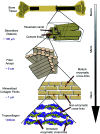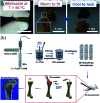Biomaterials for bone tissue engineering scaffolds: a review
- PMID: 35531040
- PMCID: PMC9070423
- DOI: 10.1039/c9ra05214c
Biomaterials for bone tissue engineering scaffolds: a review
Abstract
Bone tissue engineering has been continuously developing since the concept of "tissue engineering" has been proposed. Biomaterials that are used as the basic material for the fabrication of scaffolds play a vital role in bone tissue engineering. This paper first introduces a strategy for literature search. Then, it describes the structure, mechanical properties and materials of natural bone and the strategies of bone tissue engineering. Particularly, it focuses on the current knowledge about biomaterials used in the fabrication of bone tissue engineering scaffolds, which includes the history, types, properties and applications of biomaterials. The effects of additives such as signaling molecules, stem cells, and functional materials on the performance of the scaffolds are also discussed.
This journal is © The Royal Society of Chemistry.
Conflict of interest statement
There are no conflicts to declare.
Figures




References
Publication types
LinkOut - more resources
Full Text Sources

